Yang Ni
RETuning: Upgrading Inference-Time Scaling for Stock Movement Prediction with Large Language Models
Oct 24, 2025Abstract:Recently, large language models (LLMs) have demonstrated outstanding reasoning capabilities on mathematical and coding tasks. However, their application to financial tasks-especially the most fundamental task of stock movement prediction-remains underexplored. We study a three-class classification problem (up, hold, down) and, by analyzing existing reasoning responses, observe that: (1) LLMs follow analysts' opinions rather than exhibit a systematic, independent analytical logic (CoTs). (2) LLMs list summaries from different sources without weighing adversarial evidence, yet such counterevidence is crucial for reliable prediction. It shows that the model does not make good use of its reasoning ability to complete the task. To address this, we propose Reflective Evidence Tuning (RETuning), a cold-start method prior to reinforcement learning, to enhance prediction ability. While generating CoT, RETuning encourages dynamically constructing an analytical framework from diverse information sources, organizing and scoring evidence for price up or down based on that framework-rather than on contextual viewpoints-and finally reflecting to derive the prediction. This approach maximally aligns the model with its learned analytical framework, ensuring independent logical reasoning and reducing undue influence from context. We also build a large-scale dataset spanning all of 2024 for 5,123 A-share stocks, with long contexts (32K tokens) and over 200K samples. In addition to price and news, it incorporates analysts' opinions, quantitative reports, fundamental data, macroeconomic indicators, and similar stocks. Experiments show that RETuning successfully unlocks the model's reasoning ability in the financial domain. Inference-time scaling still works even after 6 months or on out-of-distribution stocks, since the models gain valuable insights about stock movement prediction.
Consistent causal discovery with equal error variances: a least-squares perspective
Sep 18, 2025Abstract:We consider the problem of recovering the true causal structure among a set of variables, generated by a linear acyclic structural equation model (SEM) with the error terms being independent and having equal variances. It is well-known that the true underlying directed acyclic graph (DAG) encoding the causal structure is uniquely identifiable under this assumption. In this work, we establish that the sum of minimum expected squared errors for every variable, while predicted by the best linear combination of its parent variables, is minimised if and only if the causal structure is represented by any supergraph of the true DAG. This property is further utilised to design a Bayesian DAG selection method that recovers the true graph consistently.
Enabling Group Fairness in Graph Unlearning via Bi-level Debiasing
May 14, 2025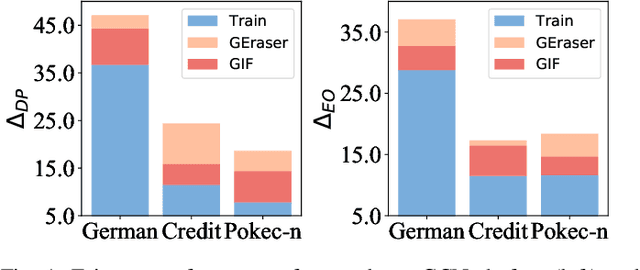
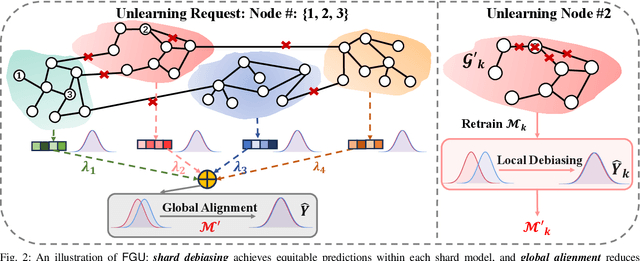
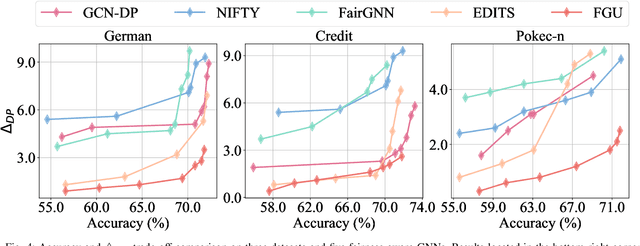
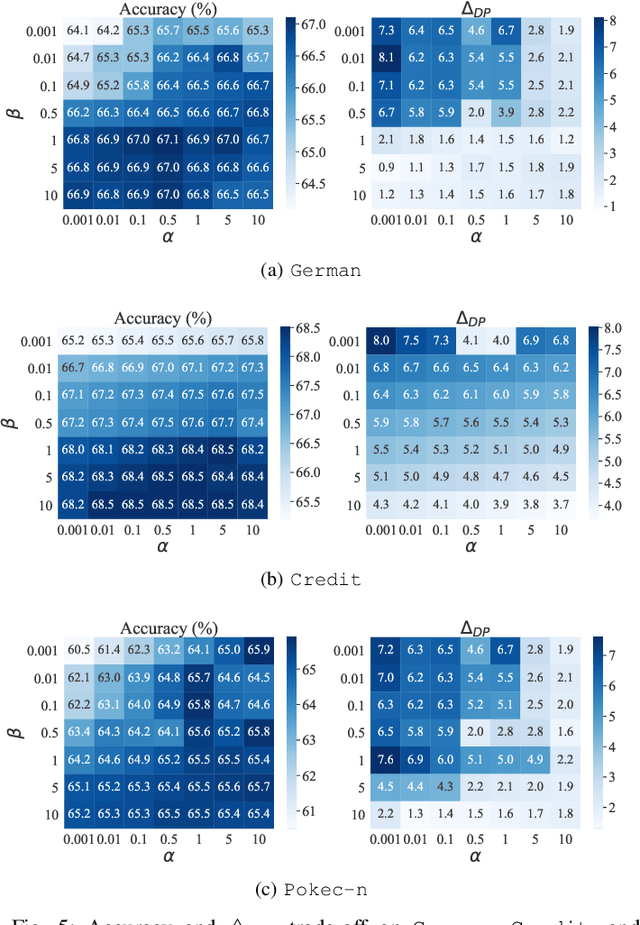
Abstract:Graph unlearning is a crucial approach for protecting user privacy by erasing the influence of user data on trained graph models. Recent developments in graph unlearning methods have primarily focused on maintaining model prediction performance while removing user information. However, we have observed that when user information is deleted from the model, the prediction distribution across different sensitive groups often changes. Furthermore, graph models are shown to be prone to amplifying biases, making the study of fairness in graph unlearning particularly important. This raises the question: Does graph unlearning actually introduce bias? Our findings indicate that the predictions of post-unlearning models become highly correlated with sensitive attributes, confirming the introduction of bias in the graph unlearning process. To address this issue, we propose a fair graph unlearning method, FGU. To guarantee privacy, FGU trains shard models on partitioned subgraphs, unlearns the requested data from the corresponding subgraphs, and retrains the shard models on the modified subgraphs. To ensure fairness, FGU employs a bi-level debiasing process: it first enables shard-level fairness by incorporating a fairness regularizer in the shard model retraining, and then achieves global-level fairness by aligning all shard models to minimize global disparity. Our experiments demonstrate that FGU achieves superior fairness while maintaining privacy and accuracy. Additionally, FGU is robust to diverse unlearning requests, ensuring fairness and utility performance across various data distributions.
Bayesian Density-Density Regression with Application to Cell-Cell Communications
Apr 17, 2025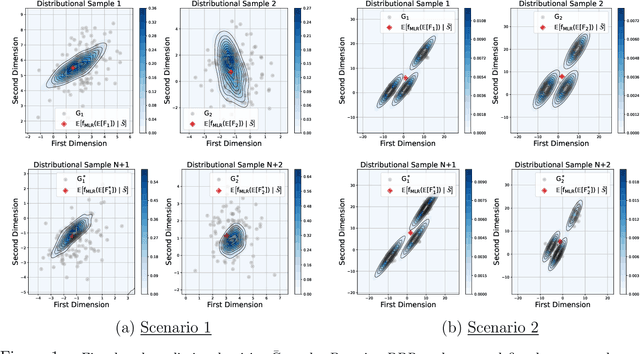
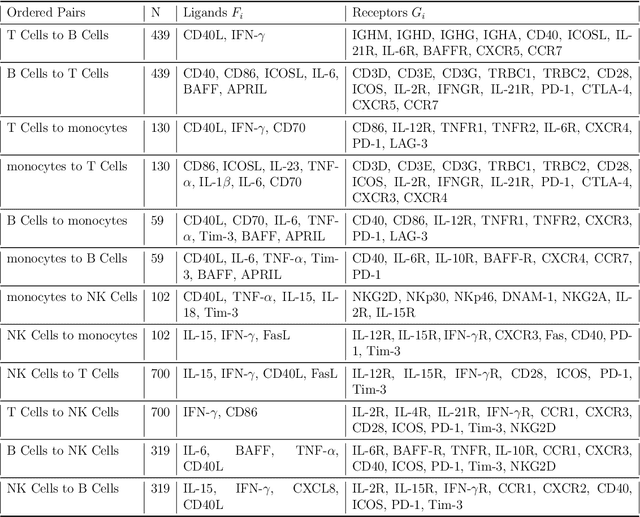

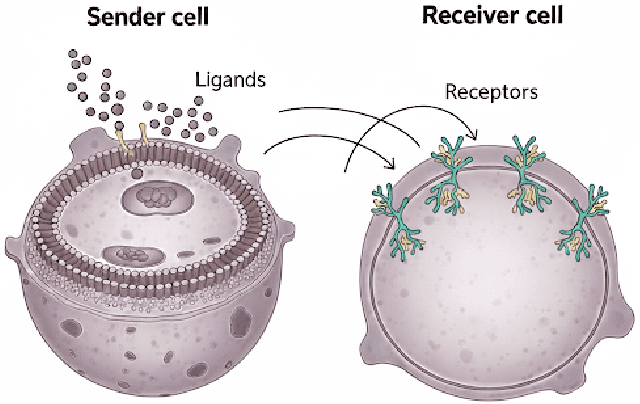
Abstract:We introduce a scalable framework for regressing multivariate distributions onto multivariate distributions, motivated by the application of inferring cell-cell communication from population-scale single-cell data. The observed data consist of pairs of multivariate distributions for ligands from one cell type and corresponding receptors from another. For each ordered pair $e=(l,r)$ of cell types $(l \neq r)$ and each sample $i = 1, \ldots, n$, we observe a pair of distributions $(F_{ei}, G_{ei})$ of gene expressions for ligands and receptors of cell types $l$ and $r$, respectively. The aim is to set up a regression of receptor distributions $G_{ei}$ given ligand distributions $F_{ei}$. A key challenge is that these distributions reside in distinct spaces of differing dimensions. We formulate the regression of multivariate densities on multivariate densities using a generalized Bayes framework with the sliced Wasserstein distance between fitted and observed distributions. Finally, we use inference under such regressions to define a directed graph for cell-cell communications.
LVLM_CSP: Accelerating Large Vision Language Models via Clustering, Scattering, and Pruning for Reasoning Segmentation
Apr 15, 2025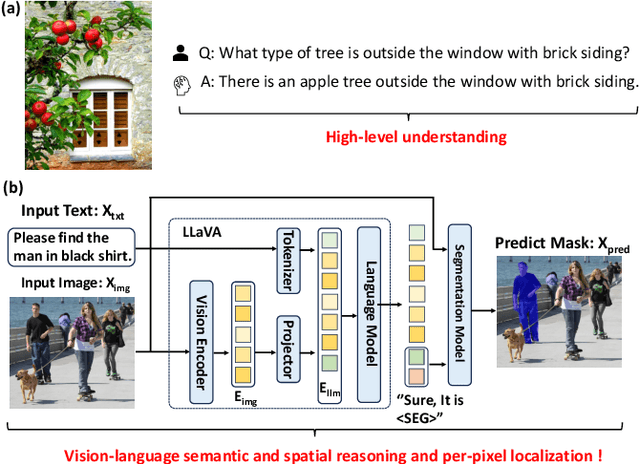

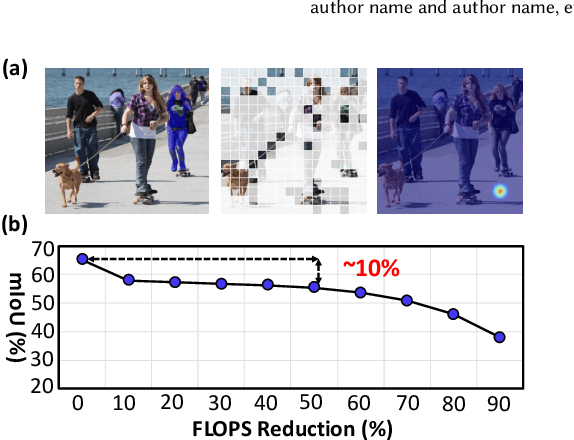
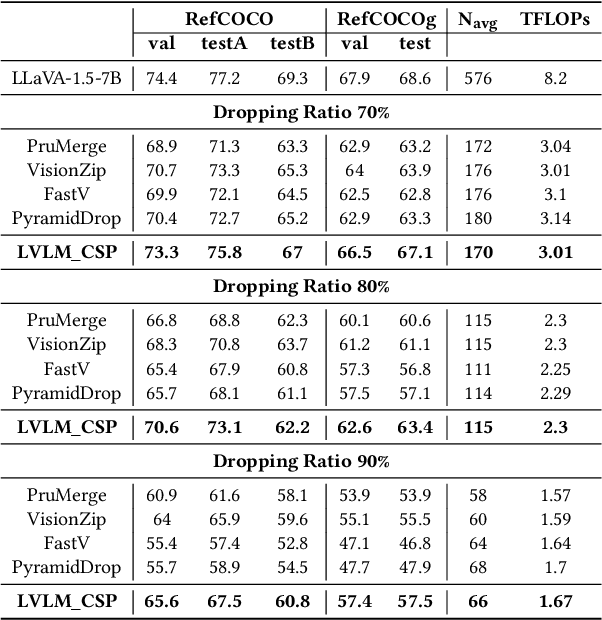
Abstract:Large Vision Language Models (LVLMs) have been widely adopted to guide vision foundation models in performing reasoning segmentation tasks, achieving impressive performance. However, the substantial computational overhead associated with LVLMs presents a new challenge. The primary source of this computational cost arises from processing hundreds of image tokens. Therefore, an effective strategy to mitigate such overhead is to reduce the number of image tokens, a process known as image token pruning. Previous studies on image token pruning for LVLMs have primarily focused on high level visual understanding tasks, such as visual question answering and image captioning. In contrast, guiding vision foundation models to generate accurate visual masks based on textual queries demands precise semantic and spatial reasoning capabilities. Consequently, pruning methods must carefully control individual image tokens throughout the LVLM reasoning process. Our empirical analysis reveals that existing methods struggle to adequately balance reductions in computational overhead with the necessity to maintain high segmentation accuracy. In this work, we propose LVLM_CSP, a novel training free visual token pruning method specifically designed for LVLM based reasoning segmentation tasks. LVLM_CSP consists of three stages: clustering, scattering, and pruning. Initially, the LVLM performs coarse-grained visual reasoning using a subset of selected image tokens. Next, fine grained reasoning is conducted, and finally, most visual tokens are pruned in the last stage. Extensive experiments demonstrate that LVLM_CSP achieves a 65% reduction in image token inference FLOPs with virtually no accuracy degradation, and a 70% reduction with only a minor 1% drop in accuracy on the 7B LVLM.
PacketCLIP: Multi-Modal Embedding of Network Traffic and Language for Cybersecurity Reasoning
Mar 05, 2025Abstract:Traffic classification is vital for cybersecurity, yet encrypted traffic poses significant challenges. We present PacketCLIP, a multi-modal framework combining packet data with natural language semantics through contrastive pretraining and hierarchical Graph Neural Network (GNN) reasoning. PacketCLIP integrates semantic reasoning with efficient classification, enabling robust detection of anomalies in encrypted network flows. By aligning textual descriptions with packet behaviors, it offers enhanced interpretability, scalability, and practical applicability across diverse security scenarios. PacketCLIP achieves a 95% mean AUC, outperforms baselines by 11.6%, and reduces model size by 92%, making it ideal for real-time anomaly detection. By bridging advanced machine learning techniques and practical cybersecurity needs, PacketCLIP provides a foundation for scalable, efficient, and interpretable solutions to tackle encrypted traffic classification and network intrusion detection challenges in resource-constrained environments.
Tell Me What to Track: Infusing Robust Language Guidance for Enhanced Referring Multi-Object Tracking
Dec 17, 2024Abstract:Referring multi-object tracking (RMOT) is an emerging cross-modal task that aims to localize an arbitrary number of targets based on a language expression and continuously track them in a video. This intricate task involves reasoning on multi-modal data and precise target localization with temporal association. However, prior studies overlook the imbalanced data distribution between newborn targets and existing targets due to the nature of the task. In addition, they only indirectly fuse multi-modal features, struggling to deliver clear guidance on newborn target detection. To solve the above issues, we conduct a collaborative matching strategy to alleviate the impact of the imbalance, boosting the ability to detect newborn targets while maintaining tracking performance. In the encoder, we integrate and enhance the cross-modal and multi-scale fusion, overcoming the bottlenecks in previous work, where limited multi-modal information is shared and interacted between feature maps. In the decoder, we also develop a referring-infused adaptation that provides explicit referring guidance through the query tokens. The experiments showcase the superior performance of our model (+3.42%) compared to prior works, demonstrating the effectiveness of our designs.
VLTP: Vision-Language Guided Token Pruning for Task-Oriented Segmentation
Sep 13, 2024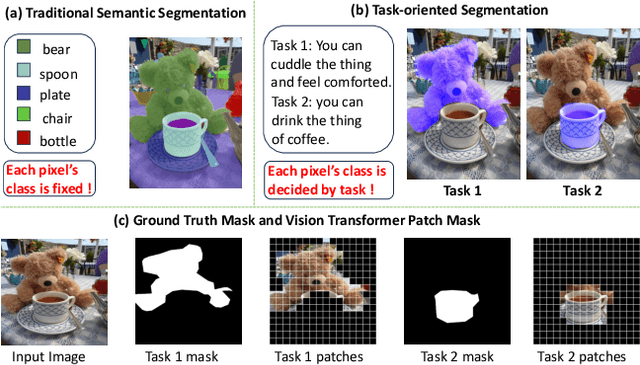
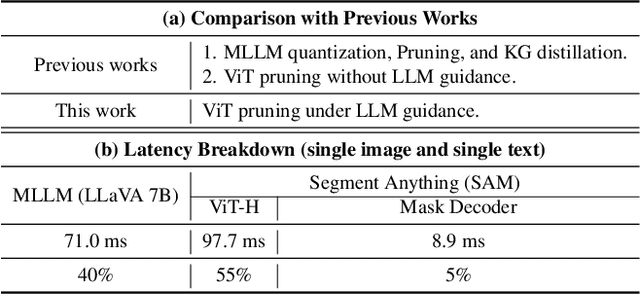
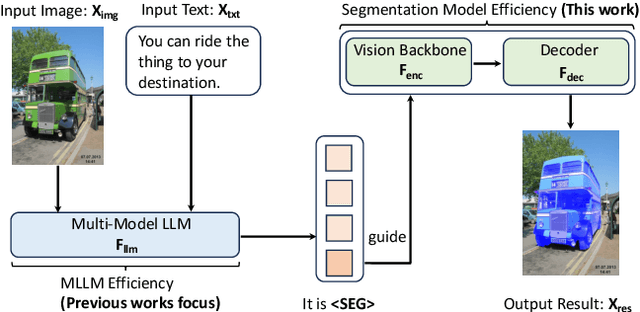
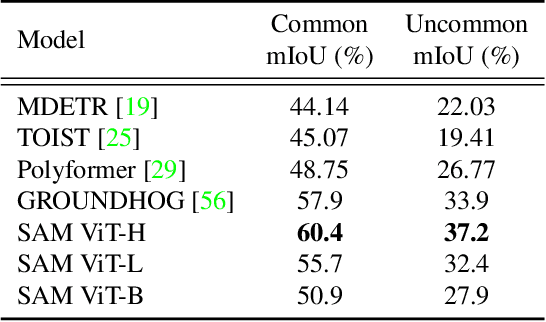
Abstract:Vision Transformers (ViTs) have emerged as the backbone of many segmentation models, consistently achieving state-of-the-art (SOTA) performance. However, their success comes at a significant computational cost. Image token pruning is one of the most effective strategies to address this complexity. However, previous approaches fall short when applied to more complex task-oriented segmentation (TOS), where the class of each image patch is not predefined but dependent on the specific input task. This work introduces the Vision Language Guided Token Pruning (VLTP), a novel token pruning mechanism that can accelerate ViTbased segmentation models, particularly for TOS guided by multi-modal large language model (MLLM). We argue that ViT does not need to process every image token through all of its layers only the tokens related to reasoning tasks are necessary. We design a new pruning decoder to take both image tokens and vision-language guidance as input to predict the relevance of each image token to the task. Only image tokens with high relevance are passed to deeper layers of the ViT. Experiments show that the VLTP framework reduces the computational costs of ViT by approximately 25% without performance degradation and by around 40% with only a 1% performance drop.
Recoverable Anonymization for Pose Estimation: A Privacy-Enhancing Approach
Sep 01, 2024Abstract:Human pose estimation (HPE) is crucial for various applications. However, deploying HPE algorithms in surveillance contexts raises significant privacy concerns due to the potential leakage of sensitive personal information (SPI) such as facial features, and ethnicity. Existing privacy-enhancing methods often compromise either privacy or performance, or they require costly additional modalities. We propose a novel privacy-enhancing system that generates privacy-enhanced portraits while maintaining high HPE performance. Our key innovations include the reversible recovery of SPI for authorized personnel and the preservation of contextual information. By jointly optimizing a privacy-enhancing module, a privacy recovery module, and a pose estimator, our system ensures robust privacy protection, efficient SPI recovery, and high-performance HPE. Experimental results demonstrate the system's robust performance in privacy enhancement, SPI recovery, and HPE.
Generalized Criterion for Identifiability of Additive Noise Models Using Majorization
Apr 08, 2024



Abstract:The discovery of causal relationships from observational data is very challenging. Many recent approaches rely on complexity or uncertainty concepts to impose constraints on probability distributions, aiming to identify specific classes of directed acyclic graph (DAG) models. In this paper, we introduce a novel identifiability criterion for DAGs that places constraints on the conditional variances of additive noise models. We demonstrate that this criterion extends and generalizes existing identifiability criteria in the literature that employ (conditional) variances as measures of uncertainty in (conditional) distributions. For linear Structural Equation Models, we present a new algorithm that leverages the concept of weak majorization applied to the diagonal elements of the Cholesky factor of the covariance matrix to learn a topological ordering of variables. Through extensive simulations and the analysis of bank connectivity data, we provide evidence of the effectiveness of our approach in successfully recovering DAGs. The code for reproducing the results in this paper is available in Supplementary Materials.
 Add to Chrome
Add to Chrome Add to Firefox
Add to Firefox Add to Edge
Add to Edge